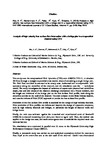Analysis of high velocity free surface flow interaction with a bridge pier in a trapezoidal channel using CFD
| dc.contributor.author | Abo, AA | |
| dc.contributor.author | Muhammad, RJ | |
| dc.contributor.author | Raby, A | |
| dc.contributor.author | Kyte, A | |
| dc.contributor.author | Greaves, DM | |
| dc.date.accessioned | 2016-09-21T08:43:41Z | |
| dc.date.issued | 2016-05-31 | |
| dc.identifier.issn | 1462-236X | |
| dc.identifier.uri | http://hdl.handle.net/10026.1/5469 | |
| dc.description.abstract |
This study uses the computational fluid dynamics (CFD) code ANSYS-CFX-12, to simulate 3D flow through a straight trapezoidal cross section channel containing a single bridge pier. The fluid flow condition is assumed to be steady state, isothermal and incompressible, with symmetry along the centerline of the channel, and the simulation uses the − turbulence model. The study investigates the impact of variations of aspect ratio (channel bed width/flow depth), bed and side slopes of the channel, discharge (represented by a Froude number), and the length and thickness of the bridge pier on the free surface flow profile, both along the centerline and the on the wall of the channel. The code is based on the finite volume method, and uses the volume of fluid (VOF) approach to predict the free surface flow profile. Prediction of the free surface flow profile is essential for the design of high velocity channels. Prior prediction of flow profiles can inform and improve the design of expensive structures, such as high velocity channels and bridges, in particular the height of channel walls and bridge decks. Firstly, the code was validated against the numerical and experimental work of Stockstill (1996) for a channel containing three piers, and found to agree well. Then, the method was applied to the design test case, and mesh convergence tests to establish the required mesh size were carried out. The simulations were conducted in parallel over 32 cores on the Plymouth University High Performance Computer Cluster (HPCC). Finally, a parametric study was carried out and analytical expressions derived for maximum flow depth at the centre-line and at the side wall of the channel. Useful non-dimensional curves and equations derived from regressions of the study data are provided, which can be used as a guideline for the design of high velocity channels containing a bridge pier. For data regressions the statistical package software Statistical Product and Service Solutions (SPSS) was used. | |
| dc.format.extent | 5-29 | |
| dc.language.iso | en | |
| dc.publisher | NAFEMS Ltd | |
| dc.subject | 4012 Fluid Mechanics and Thermal Engineering | |
| dc.subject | 4015 Maritime Engineering | |
| dc.subject | 40 Engineering | |
| dc.title | Analysis of high velocity free surface flow interaction with a bridge pier in a trapezoidal channel using CFD | |
| dc.type | journal-article | |
| plymouth.volume | 11 | |
| plymouth.publication-status | Published | |
| plymouth.journal | NAFEMS International Journal of CFD Case Studies | |
| dc.identifier.doi | 10.59972/8xzkaqhw | |
| plymouth.organisational-group | /Plymouth | |
| plymouth.organisational-group | /Plymouth/Admin Group - REF | |
| plymouth.organisational-group | /Plymouth/Admin Group - REF/REF Admin Group - FoSE | |
| plymouth.organisational-group | /Plymouth/Faculty of Science and Engineering | |
| plymouth.organisational-group | /Plymouth/PRIMaRE Publications | |
| plymouth.organisational-group | /Plymouth/REF 2021 Researchers by UoA | |
| plymouth.organisational-group | /Plymouth/REF 2021 Researchers by UoA/UoA12 Engineering | |
| plymouth.organisational-group | /Plymouth/Research Groups | |
| plymouth.organisational-group | /Plymouth/Research Groups/Marine Institute | |
| plymouth.organisational-group | /Plymouth/Users by role | |
| plymouth.organisational-group | /Plymouth/Users by role/Academics | |
| plymouth.organisational-group | /Plymouth/Users by role/Researchers in ResearchFish submission | |
| dcterms.dateAccepted | 2016-01-01 | |
| dc.rights.embargodate | 2017-5-31 | |
| dc.rights.embargoperiod | Not known | |
| rioxxterms.versionofrecord | 10.59972/8xzkaqhw | |
| rioxxterms.licenseref.uri | http://www.rioxx.net/licenses/all-rights-reserved | |
| rioxxterms.licenseref.startdate | 2016-05-31 | |
| rioxxterms.type | Journal Article/Review |


